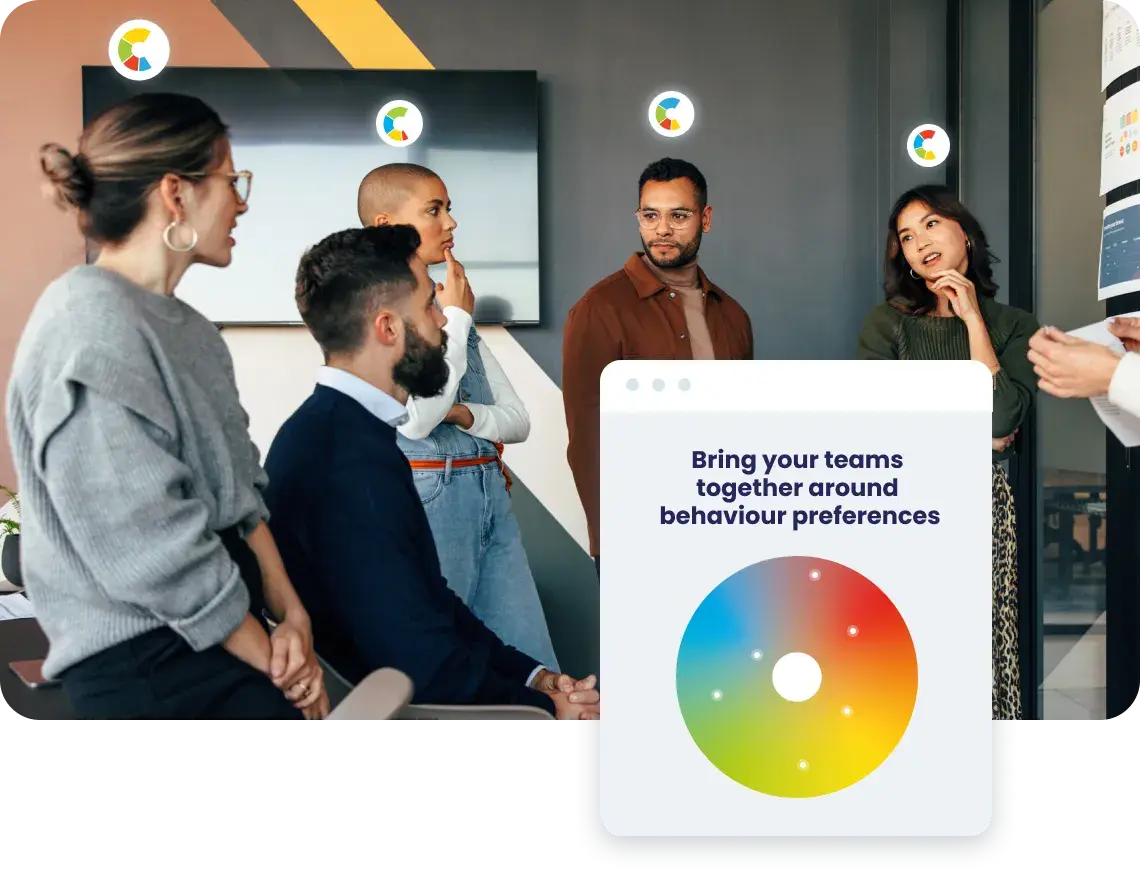
7 effective communication tips for introverts and extroverts
Effective communication is the lifeblood of any successful workplace, fostering understanding, collaboration, and ultimately, better performance. Within this guide, we will delve into seven essential communication tips tailored to nurture productive interactions among your diverse team of introverts and extroverts. Our aim is to help you unlock the full potential of your workforce by acknowledging their unique personalities and communication styles.
Put these tips in to practice to improve workplace communication, bolster interpersonal relationships, and cultivate social skills that promote empathy, adaptability, and emotional intelligence in communication. Our goal is to help you break down communication barriers and build the confidence of each team member to engage and perform at their best.
Understanding the dynamics of introversion and extroversion: What does introvert and extrovert mean?
Before delving into the tips, we need to take a moment to understand what introversion and extroversion mean. Contrary to popular belief, introversion is not just about being shy or socially awkward, nor is extroversion limited to being overly outgoing. These personality traits fall on a spectrum, and they influence how individuals gain energy and process information in social situations.
Human personality, temperament and behaviours are complex, and whilst it may not be necessary to have an extensive knowledge of psychology, flourishing relationships require us all to have at least a degree of appreciation of what makes us all different.
As Carl Jung famously stated:
If one does not understand a person, one tends to regard him as a fool.
The terms “introversion” and “extroversion” were first used by Carl Jung to describe how an individual is stimulated and energised.
- Introverts tend to be energised internally, often in their own company.
- Extroverts, tend to be energised externally, often through spending time with others.
Click here to read more on Wikipedia.
Each has a series of characteristics associated with it:

Two common models for introversion and extroversion (DISC and MBTI)
To gain a deeper understanding, let us take a moment to explore two widely recognised models: DISC and MBTI.
DISC
William Marston developed the DISC analysis in 1928.
The quadrant model presents two axes:
- Task orientation (thinking) vs people orientation (feeling)
- Introversion (processes) vs extroversion (spontaneous)

D (Dominance) and I (Influence) describe extroverted behaviour
S (Steadiness) and C (Compliance) describe introverted behaviour.
Users are given a combination of the letters in order of preference.
MBTI
The MBTI system was devised by Myers-Briggs in 1962.
This model identifies 16 personality types based on four continuums:
- Extroversion vs Introversion
- Sensing vs Intuition
- Thinking vs Feeling
- Judging vs Perceiving
The top 8 personality types relate to introversion.
The bottom 8 personality types relate to extroversion.
Users are classified in one of the boxes.
To read more about the power of psychometrics see our blog What is Psychometric Profiling: A Guide to Unlocking Employee Success.
Dispelling common myths about introversion and extroversion
It is time to debunk some common myths surrounding introversion and extroversion. These misconceptions often lead to misunderstandings and communication barriers in the workplace, hindering effective collaboration and productivity.
As many of us have probably experienced, there is a danger of over-simplification and unhelpful stereotyping. For example, it is a myth that introverts do not like people and always want to be alone.
It is also a common myth that introverts make for the best listeners. Being more naturally reflective can mean introverts get stuck in their own heads, processing almost everything internally. Listening can therefore lead introverts to reach saturation points more quickly.
In reality, every person displays a mixture of introverted and extroverted behaviour. This means that whilst we will all have a natural tendency towards one extreme or another, we will recognise characteristics of both in ourselves and in others. Understanding these things, even in simple terms, will help us relate effectively to others.
Top tips for how to relate effectively with introverts and extroverts
Here are some actionable tips to foster effective communication for both introverts and extroverts.
7 tips for how to relate effectively with introverts
Here are some suggestions of how to best relate to those with introverted behaviours bearing in mind their most common characteristics:
- Quiet– Consider the significance of the place. Crowded, noisy meeting places are most often unhelpful.
- Reflective– Give time for pauses. Silence does not mean disengagement or disagreement. Include moments of pause in meetings to allow everyone to gather their thoughts.
- Prefers focus – Stick to one issue at a time, rather than jumping between multiple topics at once. Give each topic room to be considered in the conversation flow.
- Internal processor – They may not express what they are thinking immediately. Prepare prompting questions to draw them out. Give them time to respond.
- Needs preparation time – Send information ahead of a meeting if decisions need to be made, this gives them time to reflect before the meeting, instead of in the meeting.
- Requires considered criticism – Be aware that they may have a tendency to be highly sensitive to criticism. Present constructive feedback, with time to reflect and respond later if needed.
- Enjoys solitude – Do not mistake this for disengagement. Solitude for the introvert is a place of re-energising. Give space in the office or work environment for time alone, especially if you have an open plan office or workspace.
7 tips for how to relate effectively with extroverts
Here are some suggestions of how to best relate to those with extroverted behaviours bearing in mind their most common characteristics:
- Enjoys risk – Use surprise, risk and challenge as a means of motivating. Risk is not necessarily a bad thing for a person with an extroverted preference.
- Expressive enthusiasm – Try to get comfortable with visibly displaying emotion and enthusiasm. Show you appreciate them and their contributions, and why – you are more likely to get their attention in future if you do.
- Seeks variety – Set a variety of challenges to vary their day/week/month. Encourage spontaneity, activity and fun. Avoid overly prescribing meetings but give space for spontaneous thought and interjections. Include activities that change the pace of a meeting between listening, individual and group reflection time.
- Defaults to external world – Be intentional about giving reassurance of your thoughts because if they cannot see, read or hear your thoughts they may assume the worst. Extroverts can find silence confusing.
- Enjoys social interaction – Create regular opportunities for interaction with others as this will energise. Give them time with others to rebuild energy. Do not forget personal connection time before or after a meeting.
- External processor – Will openly express what they are thinking. Give them space to externally process. They may not know what they think until they have the opportunity to hear themselves speak it out.
- Enjoys a fast pace – Keep the flow of meetings or conversations going with not too much reflection time, in order to meet the needs of extroverted preferences too. Break out in small groups in meetings, invite feedback and opinions so they can contribute. Conversations may not go in one line but break off into multiple topics.
How can I get the best out of my own preference?
We have looked at how to understand and relate to our opposite energy, but how can we better work with our own introverted or extroverted preference?
Here are some extra keys to help you improve how effectively you are maximising your own preference.
4 keys for introverts
- Sign-post early what you need – explain you need time to reflect on information before a meeting, request a meeting agenda or clear goal for the meeting, understand the timeline and ask for more time to process information if you need to make a decision.
- Communicate – practice communicating what you are processing internally so others can understand where you are in the process of making a decision. In other words, do not assume others know what you are thinking and will wait or assume the best, because they may assume you have disengaged or disapprove. For those you manage, help them to be secure in your silence and understand what processes you expect them to go through in order to get a decision from you. Silence can communicate aggression or disapproval to an extroverted colleague.
- Identify and maximise your introverted or ‘reflective’ personality strengths – Why not select three strengths in this diagram on the left side of the wheel (introverted/reflective type behaviour strengths in the blue and green colour boxes) and consciously create opportunities to offer these in your teams and working relationships. Having confidence in what you bring is going to give you energy to flex to the opposite when needed.

- Practice the opposite – Also identify the attributes you most admire, but do not currently practice, in your more extroverted colleagues. Look for ways to flex your behaviour to better connect or track with them in a meeting (for example, match their energy and step into their ideas process). This is going to help you understand and work with them. This is not about ‘faking it’ but practising your rapport skills to improve connection to perform better.
4 keys for extroverts
- Keep asking ‘so what?’ – Push the team and others to always keep in mind the action points in all meetings and conversations. Bring your strength of action orientation to the table to drive momentum.
- Embolden others in times of change – You may enjoy risk taking and find change exhilarating. Bring others into your confidence and joy by sharing the positives and benefits of what is happening and remind your introverted colleagues of the goal and big picture.
- Identify and maximise your extroverted personality strengths – Why not select three strengths in this diagram on the right side of the wheel (extroverted type behaviour strengths in the red and yellow colour boxes) and consciously create opportunities to offer these in your teams and working relationships. Being clear about what you bring is going to help you understand when you need to flex to the opposite, when needed.

- Practice the opposite – Also identify the attributes you most admire but do not currently practice, in your more introverted or reflective colleagues. Look for ways to flex your behaviour in order to better connect or track with them in a meeting (for example, slow down, ask them what they are thinking and follow-up after a meeting to understand their further thoughts). This is going to help you better understand and work with them. This is not about ‘faking it’ but practising your rapport skills to improve connection to perform better.
How can I support my introverted and extroverted colleagues?
It is almost impossible to be fully present with someone if we do not feel energised. This means that if we are seeking to build effective teams in our schools, companies, organisations, or indeed the implicit team of family within the home, we need to ensure a large proportion of their time is spent in energising endeavours.
We can help introverts do this by encouraging them towards slower-paced tasks requiring reflection and care. We can also help them by encouraging regular periods of down time to be built into daily rhythms. Introverts will not be at their best if they regularly overwork, particularly because they normally take longer to recharge.
We can help extroverts by encouraging them towards faster-paced tasks, particularly those that are either spontaneous or require regular interaction with others. It may also mean encouraging variety in their work and providing emotional or tangible rewards to motivate them. We can also help them recharge by encouraging regular opportunities for stimulation and social interaction.
Keeping one another energised is a vital means towards maximising team performance and will be far more important than simply counting the hours people work.
Conclusion
So how do we best relate to introverts and extroverts? The key is in appreciating that we are all different. This means we need to discover and maximise our own strengths and we need to be prepared to flex our behaviours and preferred ways of doing things, in order to bring out the best in others.
Want to learn more about how to embrace your team's differences? Read more about how C-me can help. Or chat to one of our C-me team:
C-me: Your go-to platform to facilitate communication, establish trust and drive performance across your organisation




